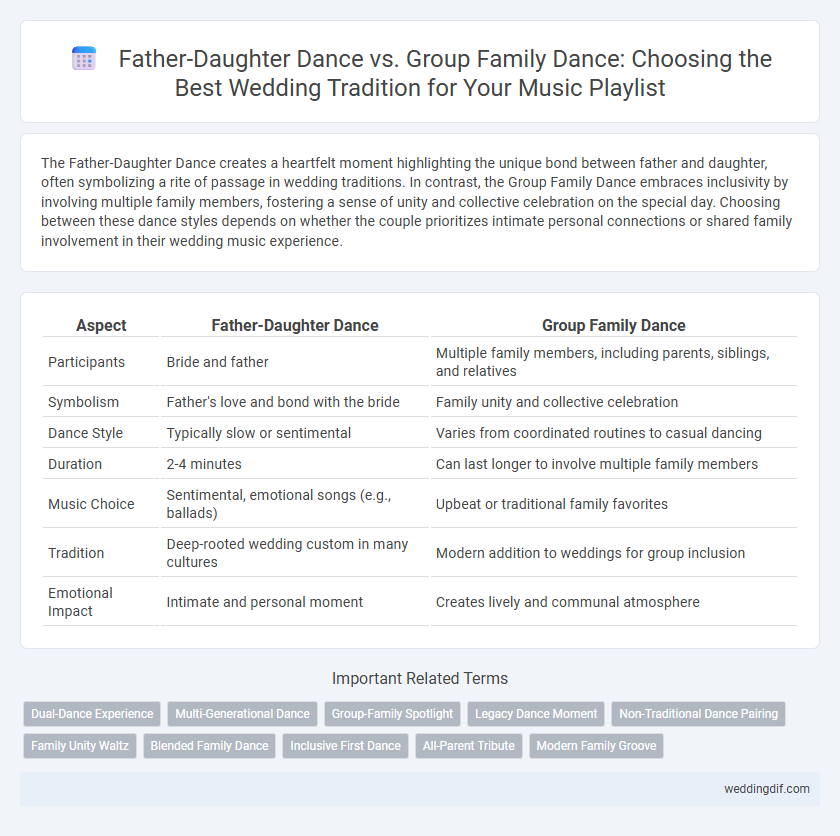The Father-Daughter Dance creates a heartfelt moment highlighting the unique bond between father and daughter, often symbolizing a rite of passage in wedding traditions. In contrast, the Group Family Dance embraces inclusivity by involving multiple family members, fostering a sense of unity and collective celebration on the special day. Choosing between these dance styles depends on whether the couple prioritizes intimate personal connections or shared family involvement in their wedding music experience.
Table of Comparison
| Aspect | Father-Daughter Dance | Group Family Dance |
|---|---|---|
| Participants | Bride and father | Multiple family members, including parents, siblings, and relatives |
| Symbolism | Father's love and bond with the bride | Family unity and collective celebration |
| Dance Style | Typically slow or sentimental | Varies from coordinated routines to casual dancing |
| Duration | 2-4 minutes | Can last longer to involve multiple family members |
| Music Choice | Sentimental, emotional songs (e.g., ballads) | Upbeat or traditional family favorites |
| Tradition | Deep-rooted wedding custom in many cultures | Modern addition to weddings for group inclusion |
| Emotional Impact | Intimate and personal moment | Creates lively and communal atmosphere |
Importance of Wedding Dance Traditions
Wedding dance traditions hold significant emotional value by symbolizing family bonds and celebrating unity through music. The father-daughter dance emphasizes the special relationship and transition in the bride's life, while group family dances foster inclusivity and collective joy among relatives and friends. Both dances contribute to the cultural richness of weddings by creating memorable moments that resonate with attendees and deepen familial connections.
Emotional Impact: Father-Daughter Dance Moments
The Father-Daughter Dance creates an intimate emotional moment, symbolizing the bond and love between a father and his daughter, often evoking tears and heartfelt expressions. This tradition highlights personal connections, offering a memorable highlight that resonates deeply with the bride, groom, and guests. In contrast, Group Family Dances promote inclusivity and shared joy but may lack the singular emotional focus that defines the Father-Daughter Dance's sentimental impact.
The Rise of Group Family Dances at Weddings
The rise of group family dances at weddings reflects a shift towards inclusive celebration, allowing multiple generations to connect through shared musical moments. Unlike the traditional father-daughter dance, group family dances encourage participation from siblings, parents, and extended family, fostering unity and collective joy. This trend highlights evolving wedding dynamics where music serves as a powerful tool for strengthening family bonds and creating memorable experiences.
Comparing Intimacy: Personal vs Collective Memories
Father-daughter dances create a deeply personal moment, highlighting the unique bond between a father and his daughter through a shared melody that evokes intimate emotions. Group family dances foster collective memories by involving multiple generations, strengthening familial unity and celebrating shared heritage in a communal setting. Choosing between these dance styles influences the wedding atmosphere, either emphasizing individual relationships or the broader family connection through music.
Song Selection: Solo vs Family-Friendly Tunes
Father-daughter dances typically feature sentimental solo songs that highlight the unique bond between the bride and her father, often focusing on lyrics that express love and gratitude. In contrast, group family dances prioritize upbeat, family-friendly tunes that encourage participation from guests of all ages, fostering a lively and inclusive atmosphere. Selecting the right song involves balancing emotional storytelling with broad appeal to ensure both intimate moments and collective celebration.
Generational Perspectives on Dance Traditions
Father-daughter dances often emphasize an intimate, emotional connection symbolizing paternal protection and generational continuity, resonating deeply with older generations who value personalized family rituals. Group family dances reflect contemporary trends toward inclusivity and collective celebration, appealing to younger generations who prioritize shared experiences and holistic family unity. These differing perspectives highlight evolving cultural values where traditional one-on-one dances coexist with dynamic group performances in wedding ceremonies.
Inclusivity: Honoring Diverse Family Structures
Father-daughter dances celebrate the unique bond between fathers and daughters but may exclude non-traditional family dynamics. Group family dances embrace inclusivity by involving all family members, regardless of structure, highlighting diverse relationships. This approach fosters a welcoming atmosphere that honors blended families, single parents, and extended relatives in wedding celebrations.
Choreography: Simple Steps or Coordinated Group Routines
Father-daughter dances often feature simple steps designed to highlight the emotional connection between the pair, emphasizing intimacy and personal moments. Group family dances require coordinated choreography that balances each dancer's movements, creating a visually engaging routine that includes everyone. Choosing between the two depends on the couple's preference for sentimental simplicity or energetic group participation in the wedding celebration.
Photography & Videography: Capturing Dance Highlights
Father-Daughter Dance offers photographers and videographers intimate moments, emphasizing emotional expressions and detailed close-ups, creating timeless keepsakes. Group Family Dances present dynamic visuals with multiple participants, capturing lively interactions and wide-angle shots that showcase family unity and energy. Both dance types provide unique opportunities for creative composition and storytelling, enhancing the wedding album's emotional depth.
Guest Experience: Engaging the Audience
Father-Daughter Dance creates an intimate, emotional moment spotlighting a special bond, often evoking heartfelt reactions from guests. Group Family Dance fosters inclusivity by encouraging multiple family members to participate, enhancing communal joy and active audience engagement. Both approaches enrich the wedding atmosphere, but group dances typically generate higher energy and collective celebration among guests.
Father-Daughter Dance vs Group Family Dance for wedding tradition Infographic

 weddingdif.com
weddingdif.com